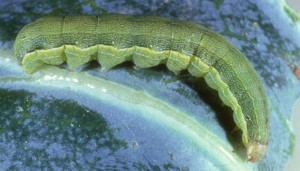Ethan Carter, UF/IFAS Extension Regional Row Crop IPM Agent & Mark Mauldin, UF/IFAS Extension Washington County
Disease
White mold had a huge impact on peanut yield last year from Jay to Marianna. The impact largely went unnoticed until harvest, when a conspicuous lack of pods was discovered, despite a great foliar canopy and strong spray programs. Hopefully we can avoid a similar scenario this year.
There is no silver bullet for disease control and there are many products available on the market for program combinations. High temperatures and recent rains, with more on the way, make disease control an immediate priority. Perfect white mold conditions and documented cases in local fields mean that growers need to be aggressive with spray programs. Applications specifically targeting white mold are generally made in the 60 and 90-days after planting time-frame. Correct timing, use of strong white mold products, and getting them down to the plant crown through high water spray volume, rainfall or irrigation is key. White mold products examples include Convoy, Excalia, Fontelis, Umbra, and Elatus (not an exhaustive list). Some of these will benefit from the addition of chlorothalonil, Alto, Domark, or Miravis for leaf spot activity. As the season progresses and fields age past 60 days, leaf spot becomes a larger concern, especially during this hot rainy weather. Products such like Provost Silver and Lucento (among others) have strong leaf spot and fair white mold activity.
To get more information pertaining to different suggested product timings or position placement in a spray program, compare Peanut Rx programs (dropdown box- choose a management plan) or contact your local extension agent.
–
Insects

Larva of a beet armyworm, Spodoptera exigua (Hubner). Photograph by John Capinera, University of Florida.
Caterpillars are being found across Florida and Georgia peanut fields. Lesser corn stalk borers (LCB) are most common in dryland fields but infest irrigated fields as well. Recent rainy weather will slow them down but will not kill them, especially with high populations. Scouting for this pest is done by checking 10 random 3-foot spots in the field. Finding a LCB at 3 of the 10 checks constitutes the spray threshold. Diamond and Vantacor are both effective controls for this pest.
The foliar feeding caterpillar threshold is 4-8 per foot of row depending on plant size and condition. Although fall armyworms (FAW) are evident in pastures, many peanut fields in Georgia and some in Florida are struggling to control the beet armyworm. In fields with smaller, lesser developed canopies, or stressed plants, the 4-5 worms per/ft threshold should be used. In fields with more developed canopies (lapped rows and beyond) and active growth, the 7-8 worms per/ft is a better threshold to use.
Products such as Intrepid, Intrepid Edge, and Diamond have been found effective for controlling beet armyworms in high population fields, while product applications with the active ingredient chlorantraniliprole (Vantacor, Besiege, Shenzi) have been ineffective in 2024, as in the past, on beet armyworms.
–
aGDD Tracker for the Florida Peanut Producing Region – 7/26/24 edition
The Tracker below shows the number of adjusted Growing Degree Days (aGDDs) accumulated by 80 fictional fields (8 locations x 10 planting dates) as of 7/26/24. Real temperature and rainfall data from each location is used as well as common soil types for the areas (Jay – sandy loam, Marianna – loamy sand, Marianna Irrigated – sand, Monticello – loamy sand, Live Oak and Bronson – sand). Peanuts reach physiological maturity after the accumulation of approximately 2500 Growing Degree Days and the Tracker quantifies their progress. Use the Tracker to approximate how your fields are progressing by following the fields on the Tracker that are the most similar to yours in terms of planting date, location and irrigation status. If the aGDD value shown for your field is black (under 2300), it’s probably not time to dig. If it’s yellow (between 2300 and 2500), you’re getting close; it’s time to pull samples and pod-blast to fine tune your harvest timing. Orange (2500+) means it’s almost certainly time to harvest, but pod-blasting is always the best way to know for sure.
For more precise tracking of your fields go to PeanutFARM.org and set up your fields in the system. You will be able to enter field specific rainfall/irrigation data and soil type. Temperature data will come from the closest FAWN weather station. If you are interested in setting up your own fields on PeanutFARM.org don’t hesitate to contact me for assistance.
The aGDD Tracker is compiled from data generated by PeanutFARM.org.
The dark blue bars in the cells with the aGDD values indicates progress towards 2500 aGDDs. The bar extends to the right as aGDDs are accumulated. The entire cell will be dark blue when a field has accumulated 2500 aGDDs.
It is recommended that fields be sampled and exact days-to-harvest be determined via pod-blasting once a field reaches 2300 aGDDs.
- Peanut Maturity Update – 10/9/25 - October 10, 2025
- Fall Can be a Great Time for Vegetation Management - October 3, 2025
- Peanut Maturity Update – 9/25/25 Edition - September 26, 2025
